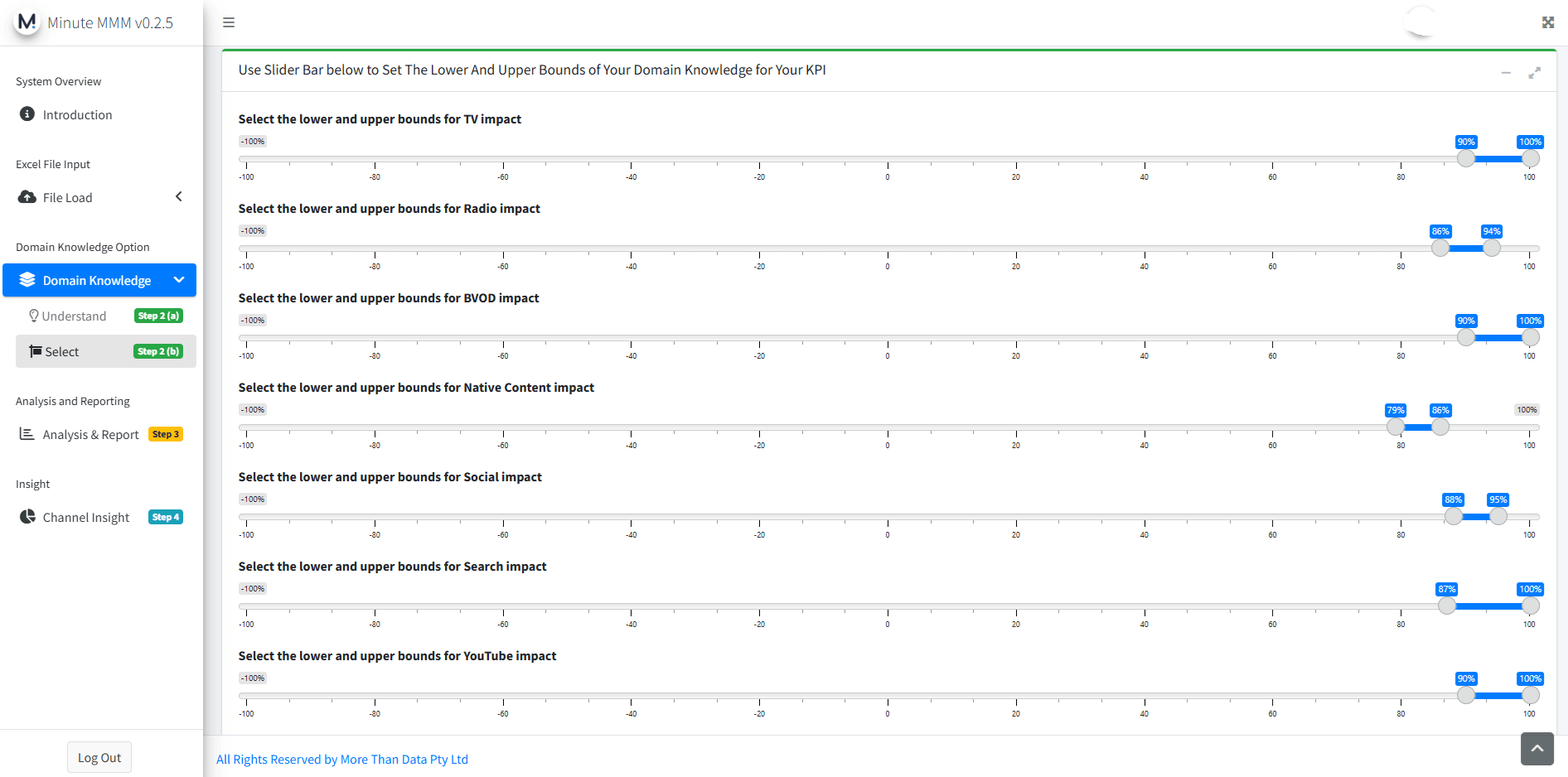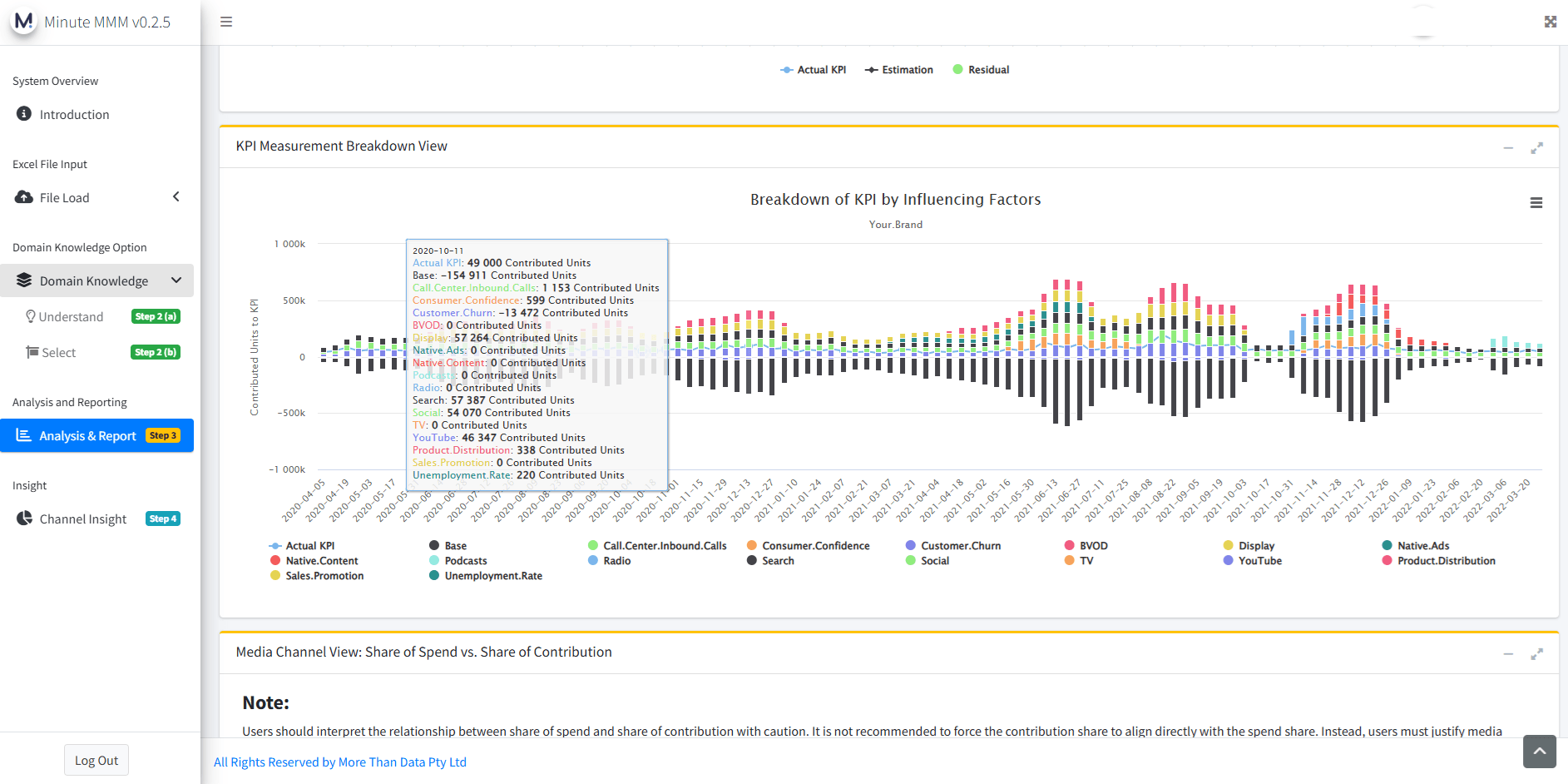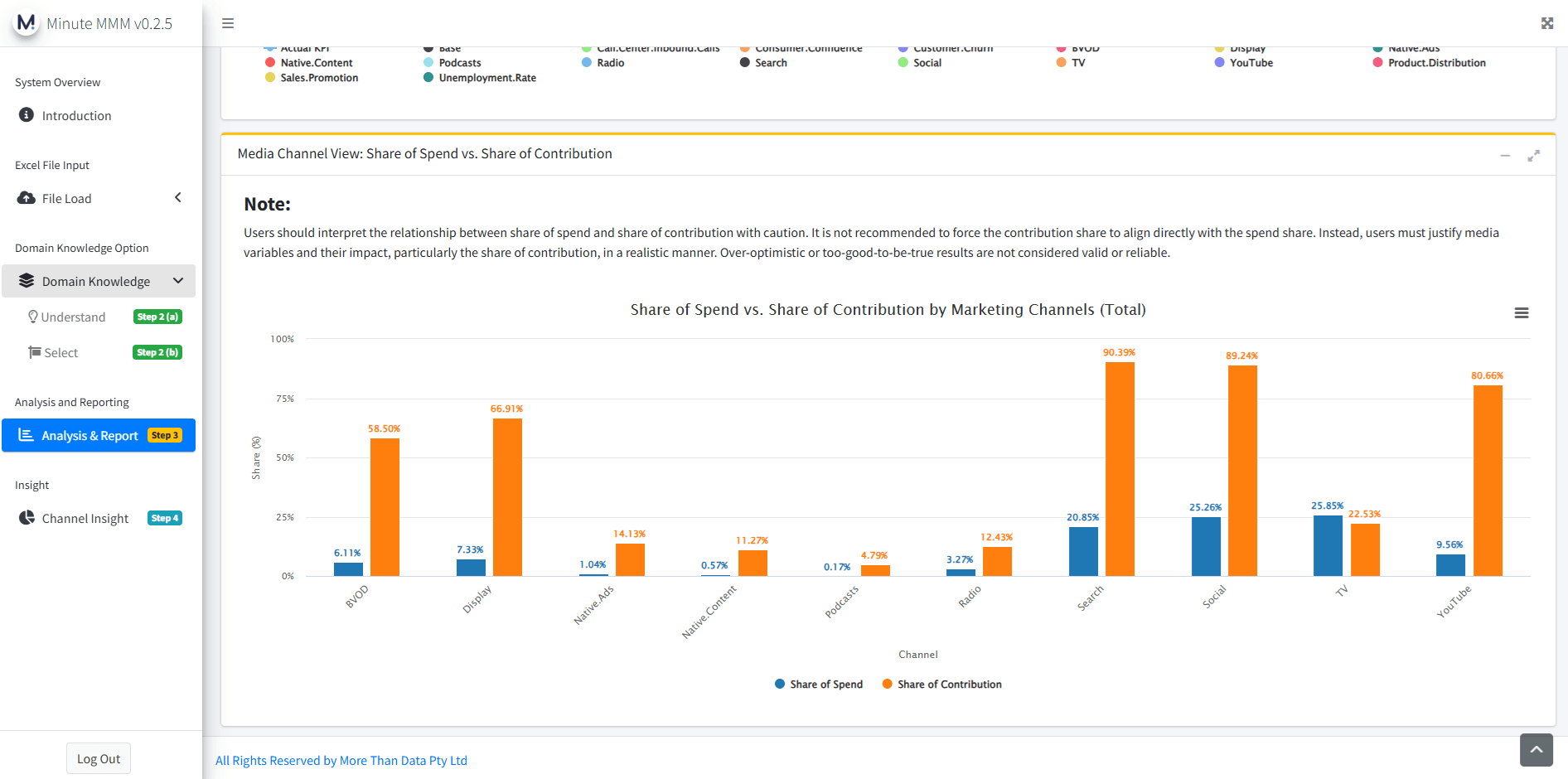Marketing Mix Modelling Is Not a Magic Box: Lessons From a Media Agency’s Journey With Minute MMM
Introduction: A Real Story Behind the Numbers
Not long ago, one of our media agency clients reached out with a curious inquiry while using Minute MMM, our self-service marketing mix modelling (MMM) SaaS platform.
This agency had been exploring the tool for some time and genuinely appreciated its simplicity, flexibility, and the control it gave them over their own marketing data. They described it as “handy, easy-to-use, and surprisingly adjustable.”
But during one of their experiments, something fascinating happened: they adjusted the settings so that nearly every media channel contributed 100% impact to sales outcomes.
On the surface, it looked like a confidence move. But in reality, it opened the door to an important conversation about what MMM is, what it is not, and how agencies and brands can use it responsibly.
This article will take you through that story, what it reveals about MMM as a methodology, and the bigger lessons for both media agencies and brands.

What Makes Minute MMM Different
Before diving into the specifics, let’s set the stage.
Minute MMM is designed as a self-service MMM tool that empowers marketers and agencies to measure and optimise their media investments without needing a PhD in data science.
One of its key features is a customisable setting that allows users to define their expectations about media variables and their impact on key performance indicators (KPIs).
In practice, this means:
- If you believe search contributes 10% to your sales, you can set it that way.
- If you’re uncertain, you can leave the system to provide a model-driven suggestion.
This flexibility is a powerful way to bridge data with human judgment and domain expertise. But it also brings responsibility.
The Reality Check: MMM Has No “Ground Truth”
One of the most important lessons in marketing science is this: MMM does not come with a built-in ground truth.
Unlike a physics experiment where gravity always pulls at 9.8 m/s², marketing systems are messy, interconnected, and ever-changing.
MMM works by creating a statistical approximation of reality. It can be shaped by:
- The quality of input data
- The assumptions you make
- The expectations you set
That’s why the customisable expectations in Minute MMM directly reflect the truth of the discipline: MMM can be anything you make it.
And that’s both empowering and risky.

Why People Think MMM Is a “Magic Box”
Many marketers and even seasoned agencies fall into a common trap: they treat MMM as a black box.
The thinking goes like this:
- Feed in your marketing spend data.
- Press the button.
- Out comes the “truth” about media effectiveness.
But that’s not how it works. MMM is not a vending machine that returns the answer you desire. It is a modelling approach that requires careful interpretation, judgment, and sometimes, humility.
When our agency client set every media channel to 100%, it wasn’t a failure. It was a reminder of how easy it is to slip into the mindset of “the model will prove whatever I need it to prove.”
The 100% Setting: What It Tells Us
So why would someone set every channel to 100%?
There are several possible reasons:
- Optimism bias: Believing that every channel works equally well.
- Pressure: Agencies often need to prove their value to clients.
- Misunderstanding: Confusing potential impact with guaranteed impact.
Whatever the motivation, the result highlights a knowledge gap. No media channel can realistically be responsible for 100% of sales.
This is not just an academic point. It has real consequences.

The Risks of Unrealistic Assumptions
When assumptions don’t align with reality, two risks emerge:
1. Business Risk
If a marketer or agency claims that one or more media channels deliver 100% of the sales, they create unrealistic expectations.
When the numbers inevitably fall short, the client relationship is strained. Trust is eroded. And in the worst cases, business partnerships collapse.
2. Reputation Risk
Agencies want to be seen as credible, trusted partners. But setting media impacts to extreme, unrealistic levels can make them look disconnected from reality.
Instead of being celebrated for hard work, they risk being questioned—or even replaced.
The Critical Role of Judgment
That’s why critical thinking is essential when using self-service MMM tools.
Every media assumption should be:
- Justified with reasoning or evidence.
- Grounded in business context.
- Flexible enough to adapt when data tells a different story.
The role of MMM is not to flatter existing beliefs, but to challenge and refine them.

Independent Validation: Why Brands Look Elsewhere
In past articles, we’ve written about how brands often seek third-party MMM vendors to validate or challenge the insights provided by their media agencies.
These articles discuss how brands’ trust can erode when media metrics are tracked and measured improperly, often resulting in wasted marketing budgets and disappointing outcomes.
The $10 Million Lesson: When "Promising Media Performance" Masks a Revenue Disaster
The Pitfalls of Vanity Metrics: How an Online Flower Brand Wasted $500,000 on Misguided Marketing
This isn’t because they distrust agencies outright. Rather, it’s because they need reassurance that the story they’re being told matches a more neutral, independent perspective.
By turning to external providers, brands gain:
- Clarity – a second opinion that either confirms or corrects assumptions.
- Transparency – insight into the logic behind the numbers.
- Confidence – the assurance that investment decisions are based on more than just optimistic reporting.
Agencies as Heroes, Not Victims
The point here is not to criticise agencies. In fact, it’s the opposite.
We want agencies to be seen as heroes of the media world—proving impact, demonstrating value, and earning the trust of the brands they work with.
MMM, when used responsibly, can be the tool that makes this possible. It provides the data backbone that shows a brand:
- “Here’s where your marketing spend really makes a difference.”
- “Here’s why the work we’re doing is driving results.”
- “Here’s how we can optimise for even greater growth.”

A Shared Mission: Supporting Agencies and Brands Alike
At More Than Data, our mission is not to take sides. Whether you are a media agency or a brand/SME, we are here to support you.
- For agencies, we provide a platform to prove the value of your work.
- For brands, we offer a transparent, independent measure of media effectiveness.
Ultimately, both sides want the same thing: clarity, confidence, and business growth.
Key Lessons From This Story
This agency’s journey with the 100% setting wasn’t a mistake—it was a learning opportunity. From it, we can extract three big lessons:
- MMM is not a magic box. It requires thoughtful setup and critical thinking.
- Assumptions matter. Setting unrealistic expectations can harm trust and credibility.
- Transparency builds relationships. Independent validation strengthens both agencies and brands.
Conclusion: Facing Reality, Building Trust
Marketing is complex. Media impact is rarely clear-cut. And no model, however advanced, can replace the need for sound judgment and honest communication.
When used responsibly, MMM is not just a measurement tool—it’s a bridge of trust between agencies and brands.
That’s why at More Than Data, we celebrate both the curiosity of agencies experimenting with our platform and the brands who seek clarity. Together, we can create a marketing ecosystem where insights are realistic, investments are transparent, and growth is shared.
